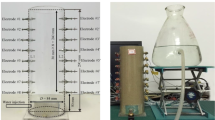Abstract
The simplified evaporation method (SEM) is frequently used for the determination of the hydraulic conductivity function (HCF) of the unsaturated soil. Usually, the mass of soil samples during evaporation is often monitored to calculate the flux. However, the balance is sensitive to the external conditions, such as the tensiometers connected by the cables to transmit data, and the cable will have a disturbing effect on the balance. In this study, a series of laboratory tests were conducted to obtain the hydraulic conductivity function of six kinds of soils, which texture ranged from sand to silty clay by using the alternative simplified evaporation method (ASEM) that reduces the sensitivity of the external environment brought by the balance. The volumetric water content near the centre depth was monitored by the soil moisture sensor, and the change of flux during evaporation was calculated by the volumetric water content. At the same time, for comparison, the mass was monitored during the evaporation process, and the mass of evaporated water was used to calculate the flux (SEM). The HCF obtained by the ASEM was consistent with that obtained by the SEM.





Similar content being viewed by others
REFERENCES
S. Assouline, K. Narkis, R. Gherabli, P. Lefort, and M. Prat, “Analysis of the impact of surface layer properties on evaporation from porous systems using column experiments and modified definition of characteristic length,” Water Resour. Res. 50 (5), 3933–3955 (2014). https://doi.org/10.1002/2013WR014489
C. R. Bezerracoelho, L. Zhuang, M. C. Barbosa, M. A. A. Soto, and M. T. van Genuchten, “Further tests of the HYPROP evaporation method for estimating the unsaturated soil hydraulic properties,” J. Hydrol. Hydromech. 66 (2), 161–169 (2018). https://doi.org/10.1515/johh-2017-0046
A. Chueasamat, T. Hori, H. Saito, T. Sato, and Y. Kohgo, “Experimental tests of slope failure due to rainfalls using 1g physical slope models,” Soils Found. 58 (2), 290–305 (2018). https://doi.org/10.1016/j.sandf.2018.02.003
J. Dane and A. Klute, “Salt effects on the hydraulic properties of a swelling soil,” Soil Sci. Soc. Am. J. 41 (6), 1043–1049 (1977). https://doi.org/10.2136/sssaj1977.03615995004100060005x
N. Ediz, İ. Bentli, and İ. Tatar, “Improvement in filtration characteristics of diatomite by calcination,” Int. J. Miner. Process. 94 (3–4), 129–134 (2010). https://doi.org/10.1016/j.minpro.2010.02.004
H. Fujimaki and A. Yanagawa, “Application of evaporation method using two tensiometers for determining unsaturated hydraulic conductivity beyond tensiometric range,” Eurasian Soil Sci. 52, 405–413 (2019). https://doi.org/10.1134/S1064229319040069
M. T. V. Genuchten, “A closed-form equation for pre- dicting the hydraulic conductivity of unsaturated soils,” Soil Sci. Soc. Am. J. 44 (5), 892–898 (1980). https://doi.org/10.2136/sssaj1980.03615995004400050002x
Q. Liu, N. Yasufuku, and K. Omine, “Self-watering system for arid area: a method to combat desertification,” Soils Found. 58 (4), 838–852 (2018). https://doi.org/10.1016/j.sandf.2018.03.013
P. A. Londra, “Simultaneous determination of water retention curve and unsaturated hydraulic conductivity of substrates using a steady-state laboratory method,” HortScience 45 (7), 1106–1112 (2010). https://doi.org/10.1590/S1984-82502013000400024
S. McNeill, L. Lilburne, S. Carrick, T. Webb, and T. Cuthill, “Pedotransfer functions for the soil water characteristics of New Zealand soils using S-map information,” Geoderma 326, 96–110 (2018). https://doi.org/10.1016/j.geoderma.2018.04.011
Y. Mualem, “A new model for predicting the hydraulic conductivity of unsaturated porous media,” Water Resour. Res. 12 (3), 513–522 (1976). https://doi.org/10.1029/WR012i003p00513
Q. Niu, D. Fratta, and Y. H. Wang, “The use of electrical conductivity measurements in the prediction of hydraulic conductivity of unsaturated soils,” J. Hydrol. 522, 475–487 (2015). https://doi.org/10.1016/j.jhydrol.2014.12.055
A. Peters and W. Durner, “Simplified evaporation method for determining soil hydraulic properties,” J. Hydrol. 356 (1–2), 147–162 (2008). https://doi.org/10.1016/j.jhydrol.2008.04.016
A. Rahimi, H. Rahardjo, and E. C. Leong, “Effect of range of soil–water characteristic curve measurements on estimation of permeability function,” Eng. Geol. 185, 96–104 (2015). https://doi.org/10.1016/j.enggeo.2014.11.017
M. Rahmati and M. R. Neyshaboury, “Soil air permeability modeling and its use for predicting unsaturated soil hydraulic conductivity,” Soil Sci. Soc. Am. J. 80 (6), 1507–1513 (2016). https://doi.org/10.2136/sssaj2015.12.0430
A. Satyanaga, H. Rahardjo, Z. H. Koh, and H. Mohamed, “Measurement of a soil-water characteristic curve and unsaturated permeability using the evaporation method and the chilled-mirror method,” J. Zhejiang Univ. Sci. 20 (5), 368–374 (2019). https://doi.org/10.1631/jzus.A1800593
U. Schindler, “Ein Schnellverfahren zur Messung der Wasserleitfähigkeit im teilgesättigten Boden an Stechzylinderproben,” Arch. Acker- Pflanzenbau Bodenkd. 24, 1–7 (1980).
U. Schindler and L. Müller, “Simplifying the evaporation method for quantifying soil hydraulic properties,” J. Plant Nutr. Soil Sci. 169 (5), 623–629 (2006). https://doi.org/10.1002/jpln.200521895
F. Stanić, N. Jaćimović, A. Ranđelović, and J. Despotović, “Laboratory investigation of hydraulic characteristics of fly ash as a fill material from the aspects of pollutant transport,” Water Sci. Technol. 76 (4), 976–982 (2017). https://doi.org/10.2166/wst.2017.243
L. Weeks and S. Richards, “Soil-water properties computed from transient flow data,” Soil Sci. Soc. Am. J. 31 (6), 721–725 (1967). https://doi.org/10.2136/sssaj1967.03615995003100060008x
W. Su, Y.-J. Cui, P.-J. Qin, F. Zhang, W.-M. Ye, and N. Conil, “Application of instantaneous profile method to determine the hydraulic conductivity of unsaturated natural stiff clay,” Eng. Geol. 243, 111–117 (2018). https://doi.org/10.1016/j.enggeo.2018.06.012
G. Wind, “Capillary conductivity data estimated by a simple method,” in Proceedings of UNESCO/IASH Symposium “Water in the Unsaturated Zone” (Wageningen, 1966), pp. 181–191.
Funding
This research was supported in part by Shandong Provincial Natural Science Foundation, China (ZR2017QD017), and the Project of Shandong Province Higher Educational Science and Technology Program (J17KA195).
Author information
Authors and Affiliations
Corresponding author
Ethics declarations
The authors declare that they have no conflict of interest.
Supplementary Information
Rights and permissions
About this article
Cite this article
Qiang Liu, Xi, P., Miao, J. et al. An Alternative Simplified Evaporation Method for Measuring the Hydraulic Conductivity Function of the Unsaturated Soils. Eurasian Soil Sc. 54, 1359–1366 (2021). https://doi.org/10.1134/S1064229321090052
Received:
Revised:
Accepted:
Published:
Issue Date:
DOI: https://doi.org/10.1134/S1064229321090052




